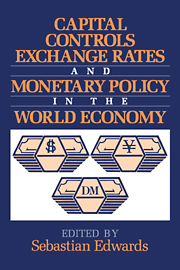Book contents
- Frontmatter
- Contents
- List of contributors
- Introduction
- Part I Monetary policy and stabilization in open economies
- 1 Stabilization and liberalization policies in semi-open economies
- 2 Monetary regime choice for a semi-open country
- 3 Capital account liberalization: bringing policy in line with reality
- Part II Capital mobility and macroeconomic policy in Europe
- Part III Capital controls and macroeconomic policy in the Asia-Pacific region
- Part IV Capital mobility and exchange rates in Latin America
- Index
1 - Stabilization and liberalization policies in semi-open economies
Published online by Cambridge University Press: 16 October 2009
- Frontmatter
- Contents
- List of contributors
- Introduction
- Part I Monetary policy and stabilization in open economies
- 1 Stabilization and liberalization policies in semi-open economies
- 2 Monetary regime choice for a semi-open country
- 3 Capital account liberalization: bringing policy in line with reality
- Part II Capital mobility and macroeconomic policy in Europe
- Part III Capital controls and macroeconomic policy in the Asia-Pacific region
- Part IV Capital mobility and exchange rates in Latin America
- Index
Summary
What is a “semi-open” economy and how is it different from an “open” economy? One meaning comes from trade theory: Whereas an open economy produces tradables, a semi-open economy has a substantial sector of nontradables. In an open economy, the main relative price is the terms of trade, but in a semi-open economy, the relative price of domestic (nontraded) and international (traded) goods, often referred to as the real exchange rate, must also be taken into account. Openness may refer to either the current account or the capital account.
Another meaning of semi-open refers to artificial restrictions to the trade or the capital accounts. A semi-open economy is one that is partially closed because of trade impediments or restrictions to capital movements. Frequently recurring problems are those of determining how and in what order artificial impediments to trade and capital movements should be lifted, and how each affects the conduct of monetary and exchange rate policy.
The liberalization and stabilization problems are in principle separate from one another. The liberalization problem is that of determining how rapidly, and to what degree, an economy should be moved toward its “natural” openness, as determined by geography, population, technology, resource structure, and transport costs. Liberalization policy involves reduction of tariffs, quotas, barriers to investment, and controls on capital movements. A problem associated with liberalization is that of determining its appropriate direction, pace, and sequence: Should liberalization policies be directed first at the trade or the capital account or should they occur simultaneously?
- Type
- Chapter
- Information
- Publisher: Cambridge University PressPrint publication year: 1995
- 2
- Cited by



